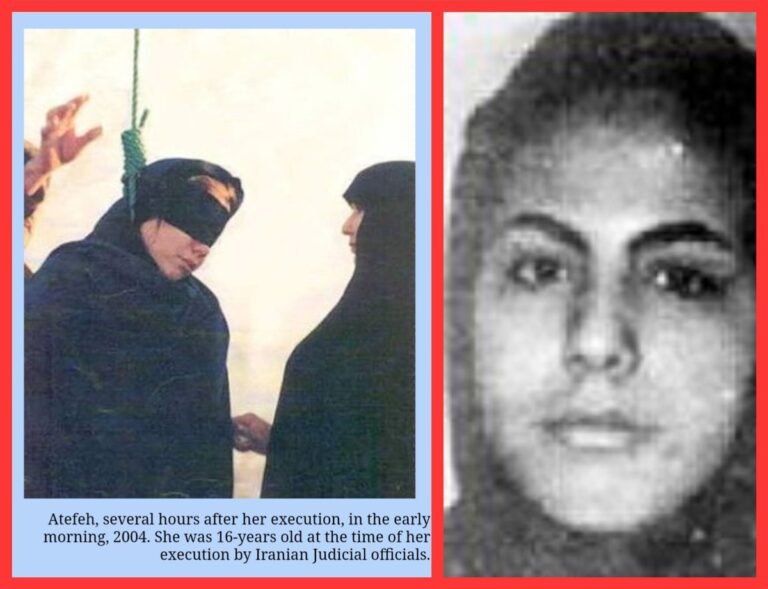The Tragic Story of Atefeh Sahaaleh: A Case of Injustice in Iran
Iran : Atefeh Rajabi Sahaaleh, a 16 year old girl was Publicly “Hang£d Till D£ath” because she was Rap£d. Yes , you read it right , she was punished by lsIamic sharia law for being rap£d!
Her grandfather lodged a FIR against her. Where multiple letters are signed by dozens of people stating that she was ill mentally presented before the Judge was ignored. And sentenced her to death at the age of 16, announced as she was 22 years old. HRs in Iran are dead.
Introduction to Atefeh Sahaaleh’s Story
Atefeh Rajabi Sahaaleh, a 16-year-old Iranian girl from Neka, Iran, became a symbol of injustice when she was executed in 2004 for “crimes against chastity.” Her story, marked by poverty, abuse, and a flawed judicial system, sparked international outrage and inspired a BBC documentary. This article explores Atefeh’s life, the circumstances leading to her execution, and the broader implications of her case. Keywords such as Atefeh Sahaaleh, Atefeh Rajabi Sahaaleh documentary, and Atefeh Sahaleh are woven throughout to ensure SEO optimization.
Early Life and Challenges
Born on September 21, 1987, Atefeh faced immense hardship from a young age. Her mother died in a car accident when she was five, and her brother drowned shortly after. Her father, struggling with drug addiction, left Atefeh to care for her elderly grandparents, who reportedly ignored her. Described as a “lively and intelligent girl,” Atefeh grew up in poverty in Neka, often wandering the streets, earning her the nickname “gypsy of Neka.” Her lack of parental guidance made her vulnerable, a factor that played a significant role in her tragic fate.
Arrests and Allegations
Atefeh’s encounters with Iran’s morality police began at 13, when she was arrested for being alone with a boy, charged with “crimes against chastity,” and sentenced to 100 lashes and a short prison term. She faced similar convictions twice more, each time enduring flogging. In May 2003, Atefeh was arrested again, accused of adultery with Ali Darabi, a 51-year-old married ex-revolutionary guard. Atefeh confessed under duress that Darabi had raped her repeatedly over three years, a secret she kept from her family. Despite her claims, proving rape under Iranian law was nearly impossible, and her confession was used against her.
Trial and Execution
The trial, presided over by Judge Haji Rezai, was deeply flawed. Rezai, who also acted as prosecutor and head of Neka’s court, took a personal dislike to Atefeh’s defiance. When she removed her hijab and threw her shoes at him, arguing that Darabi should be punished, Rezai sentenced her to death. Documents presented to Iran’s Supreme Court falsely claimed Atefeh was 22, despite her birth certificate confirming she was 16. Rezai personally traveled to Tehran to ensure the death sentence was upheld, and on August 15, 2004, Atefeh was publicly hanged from a crane in Neka. Rezai himself placed the noose around her neck, an act that underscored the case’s brutality.
International Outcry and Documentary
Atefeh’s execution violated Iran’s obligations under the International Covenant on Civil and Political Rights, which prohibits executing minors. Amnesty International labeled it a “crime against humanity” and noted that Atefeh was the tenth minor executed in Iran since 1990. Her case gained global attention through a 2006 BBC documentary, Execution of a Teenage Girl, produced by Wild Pictures. Directed by Monica Garnsey and Arash Sahami, the documentary exposed the judicial misconduct and systemic issues surrounding Atefeh’s case, interviewing her father, neighbors, and activists like Nobel Peace Prize winner Shirin Ebadi.
Aftermath and Legacy
Following Atefeh’s execution, Judge Rezai and several militia members were arrested by Iran’s Intelligence Ministry amid public and international pressure. The Supreme Court issued a posthumous pardon, but it came too late. Disturbingly, Atefeh’s body was removed from her grave in Neka Cemetery the night after her burial, and its whereabouts remain unknown. Her story continues to highlight issues of child executions, gender-based violence, and judicial corruption in Iran.
Clarifying Misspellings and Related Names
Searches for Atefeh Sahaaleh often include variations like Atefeh Sahaleh or Atefeh Khajeh, likely due to transliteration differences. Additionally, names like Atef Elshaer and Atef Mohamed Elshaer appear in related searches but have no documented connection to Atefeh’s case. These may stem from unrelated individuals or search engine confusion. For accurate information, focus on Atefeh Rajabi Sahaaleh and verified sources like Wikipedia, Amnesty International, or the BBC documentary.
Why Atefeh’s Story Matters Today
Atefeh’s case remains relevant in discussions about human rights, particularly in Iran, where child executions and harsh punishments for “moral” crimes persist. Her story underscores the need for judicial reform, better protection for minors, and support for vulnerable individuals like Atefeh, who faced mental health challenges and extreme poverty. By remembering Atefeh, we advocate for a world where no child faces such injustice.
Conclusion
The tragic fate of Atefeh Rajabi Sahaaleh is a stark reminder of the consequences of systemic failures and unchecked power. Her story, immortalized in the Atefeh Rajabi Sahaaleh documentary, continues to inspire activism and calls for justice. By sharing her story, we honor her memory and push for change. For more details, watch the BBC’s Execution of a Teenage Girl or explore reports from Amnesty International.
Sources:
- Wikipedia: Atefeh Sahaaleh
- Amnesty International Reports
- BBC Documentary: Execution of a Teenage Girl
- Iran Wire: Iran’s Death-Row for Children
SEO Keywords: Atefeh Sahaaleh, Atefeh Rajabi Sahaaleh, Atefeh Sahaleh, Atefeh Rajabi Sahaaleh documentary, Atefeh Khajeh, Iran child execution, human rights Iran, BBC documentary Atefeh Sahaaleh

